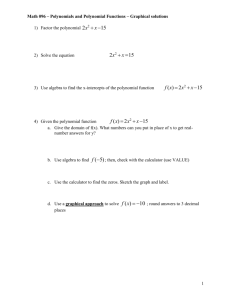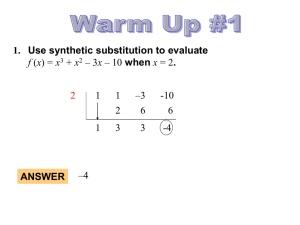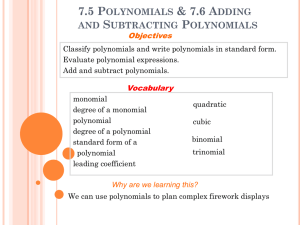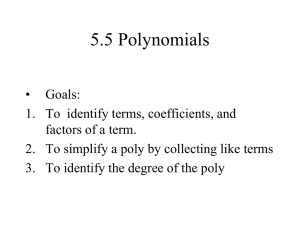Polynomial Patterns Task Answers 1-5
advertisement
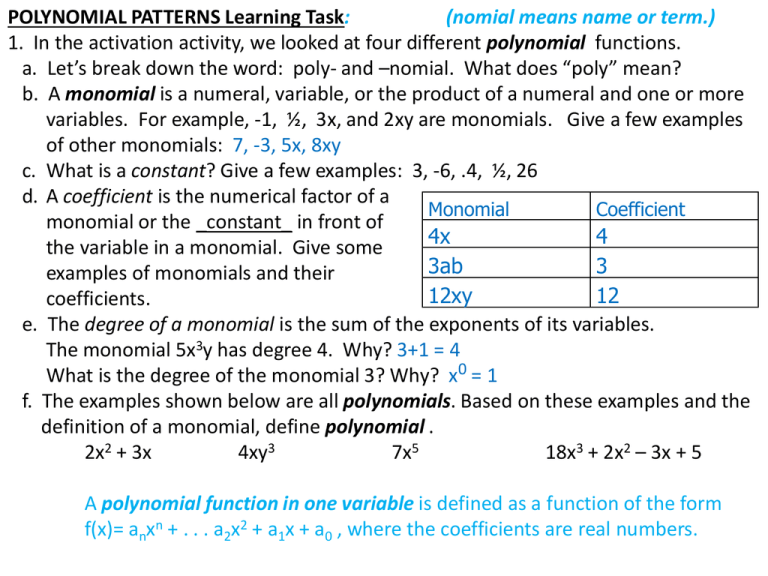
POLYNOMIAL PATTERNS Learning Task: (nomial means name or term.) 1. In the activation activity, we looked at four different polynomial functions. a. Let’s break down the word: poly- and –nomial. What does “poly” mean? b. A monomial is a numeral, variable, or the product of a numeral and one or more variables. For example, -1, ½, 3x, and 2xy are monomials. Give a few examples of other monomials: 7, -3, 5x, 8xy c. What is a constant? Give a few examples: 3, -6, .4, ½, 26 d. A coefficient is the numerical factor of a Monomial Coefficient monomial or the _constant_ in front of 4x 4 the variable in a monomial. Give some 3ab 3 examples of monomials and their 12xy 12 coefficients. e. The degree of a monomial is the sum of the exponents of its variables. The monomial 5x3y has degree 4. Why? 3+1 = 4 What is the degree of the monomial 3? Why? x0 = 1 f. The examples shown below are all polynomials. Based on these examples and the definition of a monomial, define polynomial . 2x2 + 3x 4xy3 7x5 18x3 + 2x2 – 3x + 5 A polynomial function in one variable is defined as a function of the form f(x)= anxn + . . . a2x2 + a1x + a0 , where the coefficients are real numbers. 1. a. y = x2 y = x3 y = x4 y = x5 3. Example Degree 2 2x2 + 3 -x3 x4 + 3x2 3x5 – 4x + 2 Name (based on degree) No. of terms Constant Quadratic Cubic Quartic Quintic Name (based on no. of terms) Monomial Binomial Trinomial Example Degree Name No. of terms 2 0 Constant 1 Monomial 2x2 + 3 2 Quadratic 2 Binomial -x3 3 Cubic 1 Monomial x4 + 3x2 4 Quartic 2 Binomial 3x5 – 4x + 2 5 Quintic 3 Trinomial Name Handout of Graphs of Polynomial Functions : f(x) = x2 + 2x f(x)= x ( x + 2) k(x) = x4 – 5x2 +4 k(x) = (x – 1)(x + 1)(x – 2)(x + 2) l(x) = –(x4 – 5x2 +4) l(x) = -(x-1)(x+1)(x-2)(x+2) g(x) = – 2x2 + x g(x) = x(-2x+1) m(x) = ½(x5 + 4x4 – 7x3 – 22x2 + 24x) m(x) = ½x(x - 1)(x - 2)(x + 3)(x + 4) h(x) = x3 – x h(x) = x(x – 1)(x + 1) j(x) = – x3 + 2x2 + 3x j(x) = -x(x - 3)(x + 1) n(x) = – ½(x5 + 4x4 – 7x3 – 22x2 + 24x) n(x) = -½x(x – 1)(x – 2)(x + 3)(x + 4) 5. a. For each graph, use the graph to find the x-intercepts of the functions. On the table below, write the x-intercepts of the function in the first column, then write the linear factors of the function in the second column. Function f(x) = x2 + 2x g(x) = –2x2 + x h(x) = x3 – x j(x) = –x3 + 2x2 + 3x k(x) = x4 – 5x2 + 4 l(x) = –(x4 – 5x2 + 4); x-intercepts Linear factors –2, 0 0, ½ –1, 0, 1 –1, 0, 3 f(x)= x(x + 2) g(x) = x(–2x + 1) h(x) = x(x – 1)(x + 1) j(x) = –x(x – 3)(x + 1) –2, –1, 1, 2 k(x) = (x – 1)(x + 1)(x – 2)(x +2) 1,-1,2,-2 l(x) = –(x - 1)(x + 1)(x - 2)(x + 2) m(x) = ½(x5 + 4x4 – 7x3 – 22x2 + 24x) 1,2,-3,-4 m(x) = ½x(x – 1)(x – 2)(x + 3)(x + 4) n(x) = –½(x5 + 4x4 – 7x3 – 22x2 + 24x) 1,2,-3,-4 n(x) = –½x(x – 1)(x – 2)(x + 3)(x + 4) The x-intercepts are (0,0), (3,0) and (-1,0). We can see this graphically, or we know that at x-intercepts, the value of the function is zero. We can find the x-values when j(x) equals zero using the equations: –x = 0, (x-3) = 0, and (x+1) = 0. Why might it be useful to know the linear factors of a function? You can find the zeros of the function, which are the x-intercepts. Knowing these will help you graph the function, and zeros are real solutions to the polynomial equations. How are the intercepts related to the linear factors? 5. a. Although we will not factor higher order polynomial functions in this unit, you have factored quadratic functions in Math I and Math II. For review, factor the following second degree polynomials, or quadratics. i. y = x2 – x – 12 y = (x + 3)(x – 4) ii. y = x2 + 5x – 6 y = (x - 1)(x + 6) iii. y = 2x2 – 6x – 10 y= b. Using these factors, find the roots of these three equations. 6 i. -3,4 ii. 1,-6 iii. , ii. 4 2 c. Use the relationship between the linear factors and x-intercepts to sketch graphs of the three quadratic equations above. -10 -5 5 10 5 10 -2 -4 6 -6 i. 6 4 4 2 2 -10 -5 5 10 iii. -10 -5 -2 -2 -4 -4 -6 -6 d. Although you will not need to be able to find all of the roots of higher order polynomials until a later unit, using what you already know, you can factor some polynomial equations and find their roots in a similar way. Factor y = x5 + x4 – 2x3. f(x) = x3(x – 1)(x + 2) What are the roots of this fifth order polynomial function? How many roots are there? 0, 1, -2 Why are there not five roots since this is a fifth degree polynomial? 0 is a multiple root. e. For other polynomial functions, we will not be able to draw upon our knowledge of factoring quadratic functions to find zeroes. For example, you may not be able to factor y = x3 + 8x2 + 5x - 14, but can you still find its zeros by graphing it in your calculator? How? What are the zeros of this polynomial function? * Yes, you can find the zeros on a graphing calculator. * You graph the function on the calculator and use the “zero” function on the calculator to find where the graph crosses the x-axis. * -7, -2, 1

